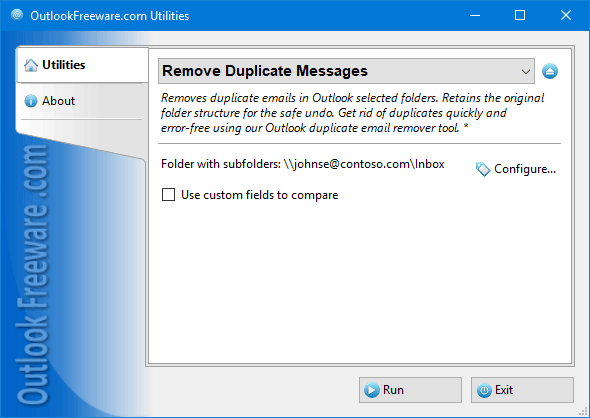

- #OUTLOOK FOR MAC SEARCH RETURNS DUPLICATE RESULTS HOW TO#
- #OUTLOOK FOR MAC SEARCH RETURNS DUPLICATE RESULTS FULL#
Understanding the differences can assist you in choosing which method is ideal for managing and removing apps on your Mac.

But before that, you should be aware of the difference between "removing" and "uninstalling" an app.
#OUTLOOK FOR MAC SEARCH RETURNS DUPLICATE RESULTS HOW TO#
If you do not need Microsoft Outlook anymore, you may need to search for how to uninstall Outlook on Mac. Microsoft Outlook is included with the Microsoft Office package on macOS. My hope is that once that’s done your search problems are at an end.Microsoft Outlook (primarily used as an email application) is a manager for personal information from Microsoft. Depending on how many messages you have, the utility will take a little or long time to rebuild the database. Choose your main identity (called, aptly enough, Main Identity) and click the Rebuild button in the bottom-right corner. In its window you’ll see any identities associated with Outlook. This causes the Microsoft Database Utility to launch. With that done, quit all Office apps and then, while holding down the Option key, launch Outlook. Rebuilding your Outlook database can fix a lot of issues. Microsoft suggests that you back up your Microsoft User Data folder before doing this. This is a sort of cure-all when Outlook misbehaves. If that doesn’t do it, you could try rebuilding the Outlook database. You can continue using your Mac as you normally would (though searching for files won’t work completely until the indexing finishes). Depending on how many files you have on your Mac this could take several minutes to a few hours to complete. This will cause a complete Spotlight reindexing. To do so, launch Terminal (found in /Applications/Utilities) and enter this command and press Return: Still no good? Maybe you need to perform a complete reset of the Spotlight index. This is the common technique for reindexing folders and volumes.Īdding and then removing a folder or volume to Spotlight preferences will cause Spotlight to reindex that item. This will force Spotlight to reindex that folder. Let it sit there for about 30 seconds and then select it and click on the minus ( – ) button to remove the folder from the window. Drag this folder into the Spotlight window (the one displaying the Privacy tab). Move to the Finder and locate your Microsoft User Data folder (which, as I’ve mentioned, is usually found in your Documents folder). Launch System Preferences, choose Spotlight, and click on the Privacy tab. Now, to the tried-and-true methods for fixing Spotlight indexing issues. This will restore the correct association. If something else appears here, click on the pop-up menu, choose Microsoft Outlook from the list that appears, and then click Change All. Select one, press Command-I to bring up the Info window, and ensure that in the Open With area of the resulting window you see Microsoft Outlook.
#OUTLOOK FOR MAC SEARCH RETURNS DUPLICATE RESULTS FULL#
To find out, travel to youruserfolder/Documents/Microsoft User Data/Office 2011 Identities/Main Identity/Data Records/Messages and then dig down through folders until you finally come to a folder full of files that end with the. When that happens Spotlight indexing won’t work correctly. I’ve heard of cases where messages have lost their association-they’re now linked with Notes, for example. If that doesn’t work, check that Outlook’s messages are indeed associated with Outlook. Ensure that your Outook messages are associated properly.


 0 kommentar(er)
0 kommentar(er)
